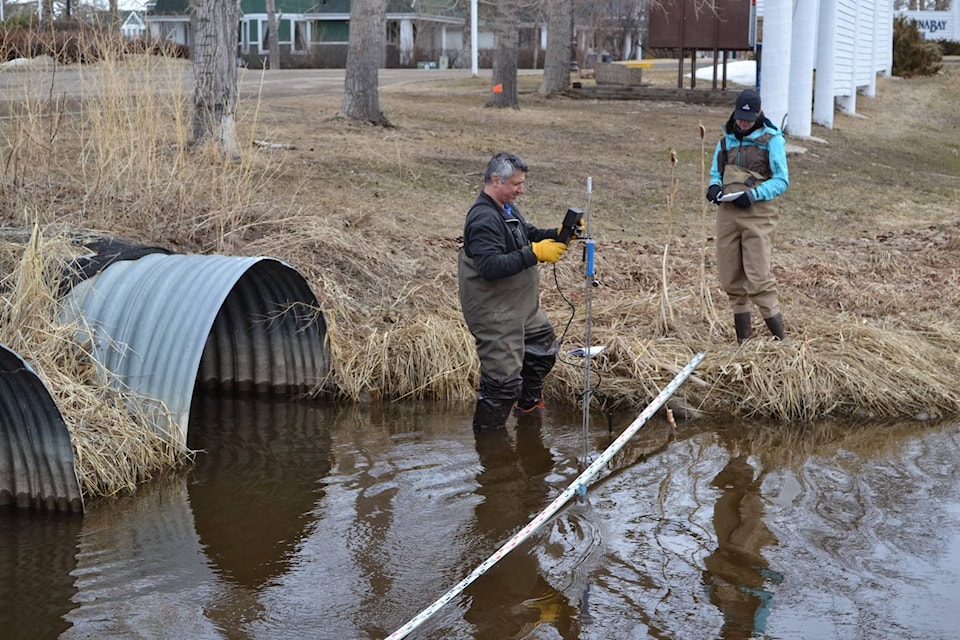The total phosphorus (TP) concentrations in the runoff in the tributaries that discharge into Sylvan Lake consistently exceed the Alberta Surface Water Quality Guideline for protection of aquatic species of 0.05 milligrams/litre. High TP from diffuse, non-point sources is a primary lake eutrophication threat. Northwest Creek in Lacombe County is the worst offender by far and is closest to Protective Notation habitat.
Best stewardship practice advises human populations in the watershed to quarantine themselves to ensure that the lake is unaffected by their presence. But those humans aren’t diffuse. They congregate in islands of people who consume inputs and emit outputs. The higher their population densities, the greater their potential as contaminant sources. Urbanized areas inside the hydrological boundary, comprising 7.5 percent of the land area, are concentrated, not diffuse. The larger 92.5 percent of the watershed land mainly in agricultural production is the diffuse source of nutrients and contaminants that is the background threat to the condition of the valued waterbody.
Attribution of the release of plant nutrients, particularly phosphorus, into streams and lakes by the agricultural sector has a long history. In its defense, we know that the agricultural community has co- existed with Sylvan Lake for more than a century without lake eutrophication. The relatively low- nutrient meso-eutrophic state of the lake has remained steady over decades. Prevention of massive changes in land use with potential to increase nutrient concentrations in runoff is the primary mission of watershed stewardship.
There’s a lot going on when we disturb the surface of the ground by farming or excavation. In major field and modeling studies, Alberta Agriculture researchers showed that regardless of how runoff was generated and exported from fields in local watersheds, concentrations of Total Phosphorus (TP) exceeded the in-stream Alberta Surface Water Quality Guideline (ASWQG) of 0.05 mg/L TP for the protection of aquatic life.
Experts at the agency demonstrated that a linear relationship between routine Soil Test Phosphorus (STP) analyses can be used to predict the phosphorus concentration in runoff water from measured STP values. Phosphorus concentration in runoff water at the edge of field can be predicted using STP values. Across Alberta with different terrains, soil types, and precipitation the majority of ecodistricts had a mean STP value between 25 and 30 mg/L in the top 15 cm of soil. Therefore, using the TP relationship for release from the top 0- to 15-cm layer, the predicted TP concentration in runoff was 0.52 mg/L TP from a field with an STP value of 25 mg/kg, about 10 times higher than the ASWQG.
While conversion of agricultural land into developed urban land increases its assessed value and tax revenue by 100 times or more, it also triggers and aggravates the release of nutrient phosphorus. That threatens the eutrophic state of Sylvan Lake, existing real estate, and natural and recreational values. Excess land development that impacts those assets is a primary stewardship concern.
Agricultural is a diffuse source of both nitrogen (N) and phosphorus (P) nutrients in runoff as a result of the cycle of growth and decay of organic material on the land. The background threat created by
municipalities is proportional to their land area percentage. Today, that order is Lacombe County, Red Deer County, the Town of Sylvan Lake, then all Summer Villages.
The phosphorus cycle cannot be stopped. P is present in all the cell walls of plant and animal tissues and DNA. Chemical processes aided by enzymes in bacteria, fungi, insects and worms in the soil break down, convert, and recycle P-containing plant residues into mobile chemicals.
That is why diffuse sources are a permanent and chronic threat to the state of the lake. During their growth phases plant roots extract needed elements from the soil, particularly from the inter-granular water in the root zone that contains soluble building-block species of N and P. Plant decay, promoted by organisms in the soil, is continuous and releases cell nutrients back to the soil inventory for re-use. Precipitation flushes nutrients to the surface of the soil, then into streams that enter water bodies. Farmers use soil test chemical analyses like STP values to determine how much fertilizer must be added to grow the next crop. Growing food crops mines the soil and harvesting removes nutrients that must be replaced to maintain future crop yields. Farmers and their advisors are experts at matching fertilizer applications to crop needs and avoiding losses to runoff and into water bodies.
Typically, nutrient levels are the highest in spring runoff, then drop as the ground warms up and plants grow, trap, and retain N and P. SLWSS, SLMC and MBHA water quality sampling projects on the main tributaries Golf Course and Northwest Creeks confirm Alberta Agriculture findings. Data from other Sylvan Lake tributaries follow the same pattern. While tributary concentrations of N and P have always been above those measured in Sylvan Lake, it is the total annual lake loading that must be monitored and regulated. The annual nutrient cycles are primary threats to the eutrophic state of Sylvan Lake.
Visit slwss.org for more detail on nutrient cycles and diffuse source threats.
